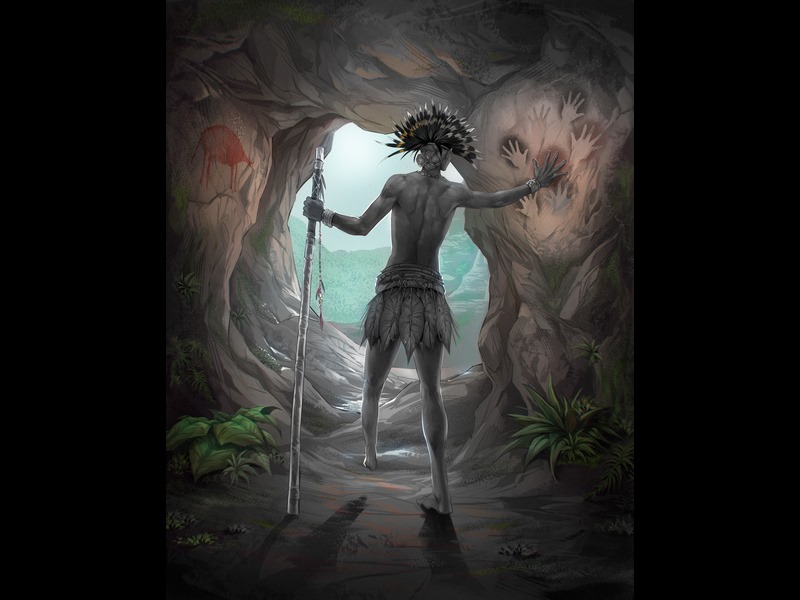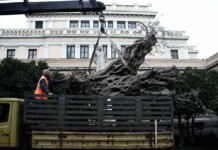
A child that lived in Borneo 31,000 years ago had its left foot amputated and survived for up to nearly a decade.
It is the oldest evidence of surgical limb amputation and pre-dates the previous record by an astonishing 24,000 years.
Those who removed the lower third of the young patient’s leg must have had detailed knowledge of anatomy and muscular and vascular systems to prevent fatal blood loss and infection.
Scientists hypothesize they may have had access to a natural antiseptic from the rainforest’s rich variety of plants. The leg bone shows a clean sloping cut made with a “sharp tool.”
The patient was an adolescent, aged 11 to 14. After the procedure they used a crutch, or perhaps even a prosthetic, to negotiate a difficult environment. Its gender is unknown, but most likely to be male.
Named TB1, its remains were buried in Liang Tebo cave on the Indonesian island of East Kalimantan, which coincidently contains some of the world’s earliest dated rock art.
“This unexpectedly early evidence of a successful limb amputation suggests at least some modern human foraging groups in tropical Asia had developed sophisticated medical knowledge and skills long before the Neolithic farming transition,” said Dr. Tim Maloney, of Griffith University, Australia.
Animal attack or accident seems unlikely, as does punishment since the individual seems to have received careful treatment after surgery and in burial.
“Furthermore, during surgery, the surrounding tissue including veins, vessels and nerves, were exposed and negotiated in such a way that allowed this individual to not only survive but also continue living with altered mobility,” added Dr. Maloney.
“Although it is not possible to determine whether infection occurred after the surgery, this individual evidently did not suffer from an infection severe enough to leave permanent skeletal markers or cause death.”
Intensive post-operative nursing and care would have been vital, such as temperature regulation, regular feeding, bathing and movement to prevent bed sores while the individual was immobile.
Gentleman, the operation was a success
At the time of death, the individual was a young adult aged about 19 or 20 in a period of history when the average age of death for adults was around 32, which can only mean the operation can be judged as a success. Its reassembled skeleton is 75% complete and has hallmarks of a male’s frame.
Before modern clinical developments such as antiseptics, most people undergoing amputations, even as recently as 200 years ago, died from blood loss and shock or subsequent infection.
Previously, the oldest known complex operation happened in France about 7,000 years ago. A Stone Age farmer’s left forearm was surgically removed and then partly healed.
“We infer the comprehensive knowledge of human anatomy, physiology and surgical procedures evident in TB1’s community is likely to have been developed by trial and error over a long period of time and transmitted inter-generationally through oral traditions of learning,” said Dr. Maloney.
“Notably, it remains unknown whether this ‘operation’ was a rare and isolated event
in the Pleistocene history of this region, or if this particular foraging society had achieved an unusually high degree of proficiency in this area.”
It’s possible that we’ve found the remains of surgical procedures before, but the poor preservation of diseased bone as well as preconceptions about the ‘primitive’ nature of early medical cultural practices among hunter gatherers, have interfered with those deductions
Professor Charlotte Roberts, an archaeologist at Durham University, who was not involved in the study, described the case as the “dawn” of surgery.
“That this child survived the procedure and is estimated to have lived for many years afterwards is astounding,” she said. “Another interesting open question is whether the child received pain management during the operation, such as sedation through the use of a plant-based medicine.”
“The hunter-gatherer community in which this person lived would have been relatively
mobile while foraging and hunting for food, and this would have made the individual’s
recovery process very challenging, considering how people recover from amputations and the need for care, rest, healing and rehabilitation.”
It would have been harder to support this child than someone in settled farming communities of later periods, where it would have been easier for people to help them at the same time as working, and the discovery shows just how comprehensive human intelligence, and sense of community is.
SHARE This Incredible Breakthrough With Your Friends On Social Media…



















